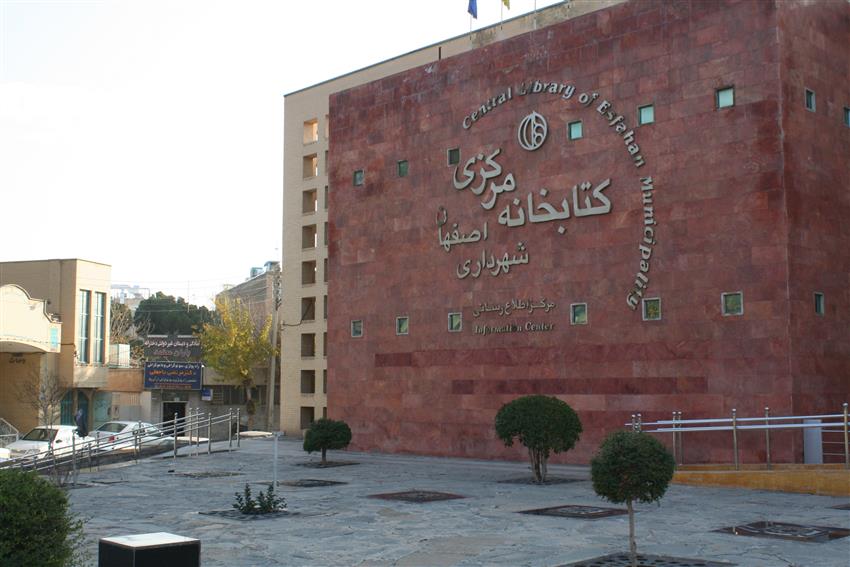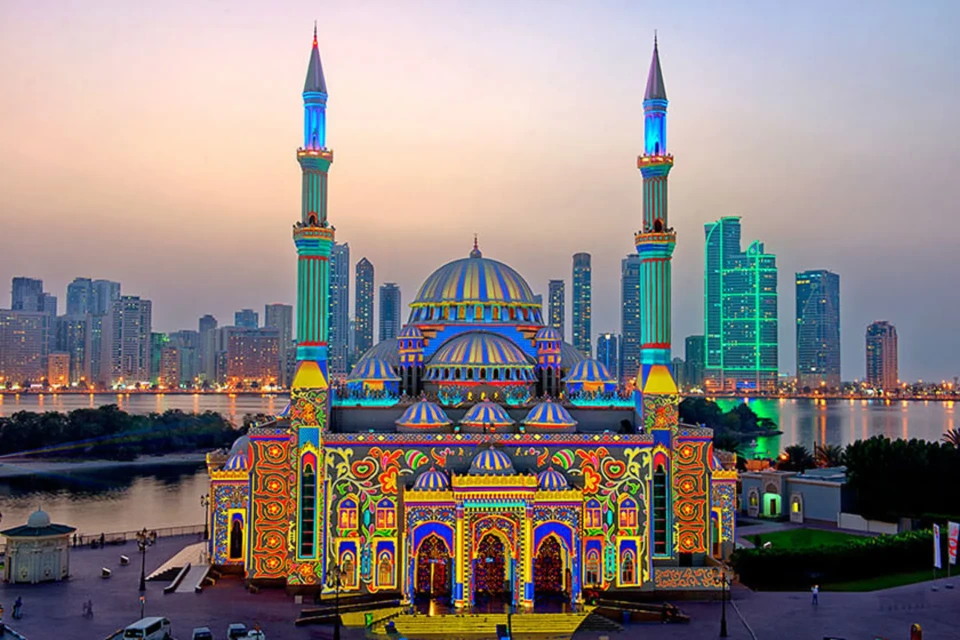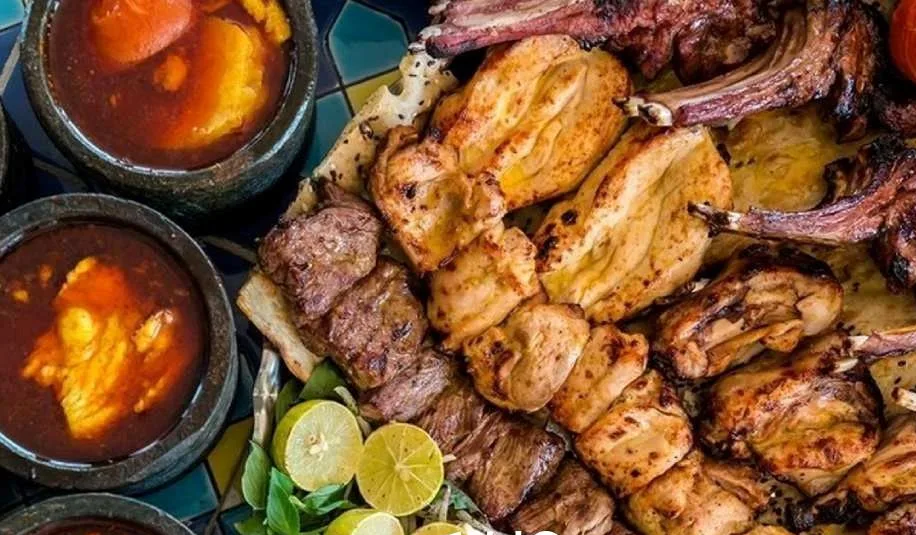Ardabil iran souvenirs
Ardabil souvenirs are among the best and most delicious Iranian souvenirs. Ardabil is a province in the northwest of Iran, centered on the city of Ardabil. This beautiful and historical city is one of the important and attractive tourist destinations in all seasons of the year. Also, the souvenirs of this spectacular city are considered to be part of the most attractive tourist goals in this city. Especially if you are interested in different foods.
Ardabil souvenirs include all kinds of sweet and sour, natural and unnatural foods. Every tourist who travels to Ardabil will not leave this city without buying Ardabil souvenirs and handicrafts. The most famous souvenir of this city is black halva and other types of halva. Buttermilk, natural honey, all kinds of sweets and delicious foods are also produced in this city and are sold as souvenirs. Of course, Ardabil souvenirs are not limited to food and handicrafts are also considered as souvenirs of Ardabil city. If you are also interested in delicious foods and sweets, join Lidoma tourism magazine to introduce Ardabil souvenirs to you fellow travelers.
What are Ardabil souvenirs?
Ardabil, as one of the oldest cities and provinces of Iran, has a rich culture and customs. Therefore, the souvenirs of this city are of great quality and attractiveness in accordance with this rich culture, from all kinds of colorful foods to handicrafts and various products. Meanwhile, Ardabil foods are more famous among tourists and travelers. If you are planning to travel to Ardabil and buy souvenirs of this city, we at Lidomatrip have provided an opportunity for you to choose your accommodation with the least amount of time and money, and then you can safely explore the heart of the city and shop. Give a souvenir. Next, we introduce the souvenirs of Ardabil and its products.
1.Carpets and Rugs:
Ardabil is famous for its high-quality handmade Persian carpets. These carpets are intricately designed and woven, often depicting traditional patterns and motifs. They are beautiful and make for a valuable souvenir.
Carpets and rugs are a significant part of Iranian culture and Ardabil, in particular, is renowned for its exceptional handcrafted rugs. Here’s more detailed information about Ardabil’s carpets and rugs:
History and Significance:
Ardabil has a long history of carpet weaving, dating back centuries. The craft has been passed down through generations and is a significant part of the region’s cultural heritage.
The Ardabil carpets are highly esteemed for their quality, design, and craftsmanship. They often reflect traditional Persian motifs, geometric patterns, and intricate designs that showcase the artistry of the weavers.
Quality and Craftsmanship:
These carpets are typically handwoven using high-quality wool or silk, and sometimes a blend of both, giving them durability and a luxurious feel.
The weavers use natural dyes, which not only produce vibrant colors but also contribute to the rugs’ longevity.
Designs and Patterns:
Ardabil carpets often feature motifs such as floral designs, geometric patterns, medallions, and intricate borders. These designs often carry cultural and symbolic meanings.
The famous “Ardabil Carpet” from the 16th century is one of the world’s oldest and most well-known Persian carpets, now displayed at the Victoria and Albert Museum in London.
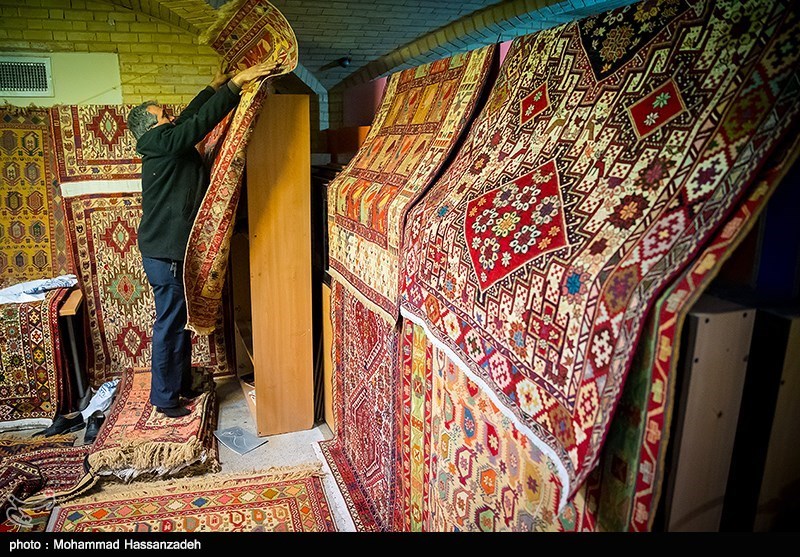
Variety and Sizes:
Ardabil rugs come in various sizes, from small area rugs to large room-sized carpets. Some are meant for hanging on walls or displaying on floors.
Purchasing:
When in Ardabil, you can find these rugs in local markets, specialized carpet shops, and bazaars. It’s advisable to buy from reputable sellers or cooperatives to ensure the authenticity and quality of the rug.
Cultural Importance:
In Iranian culture, carpets hold a special place and are often used as decorative pieces, for prayer, and even as a sign of prestige and wealth. They’re often handed down through generations.
Ardabil’s carpets and rugs are not only beautiful souvenirs but also pieces of art that carry a rich cultural heritage. They are sought after globally for their quality and timeless designs, making them a valuable addition to any home or collection.
2.Kilims:
Similar to carpets but flat-woven, kilims are also popular in Ardabil. They come in various sizes and designs, perfect for decorating floors or walls.
Kilims are a type of traditional flat-woven rug or textile, distinct from the piled carpets like those commonly found in Ardabil. These rugs are woven by interweaving the weft and warp strands to create a flat surface without a pile. Here’s more information about kilims:
Characteristics:
Weaving Technique: Kilims are made using a unique weaving technique that produces a flat surface without a pile. This technique makes them thinner and lighter than traditional pile carpets.
Patterns and Designs: Kilims often feature bold geometric patterns, stylized motifs, and vibrant colors. Designs can vary significantly based on the region and the weaver’s creativity.
Usage: They are versatile and can be used as floor coverings, wall hangings, or even as decorative pieces for furniture. Smaller kilims are also used as bags, cushion covers, or other functional items.
Cultural Significance:
Kilims have a rich historical and cultural significance in many countries, including Iran. They are not just utilitarian but also carry cultural stories and traditions. Designs and motifs can sometimes convey specific meanings or symbols.
These textiles have been crafted for centuries and are an essential part of many traditional cultures.
Production and Materials:
Kilims are often made from natural materials such as wool, cotton, or sometimes silk, depending on the region and the weaver’s preferences.
The weaving process is intricate and time-consuming, requiring skill and patience. Kilims are mostly handwoven, and this traditional craft is passed down through generations.
Acquiring Kilims:
In Ardabil and surrounding regions, you can find kilims in local markets, bazaars, or specific rug shops. Authentic kilims, made by skilled artisans, are usually available in these places.
It’s advisable to look for reputable sellers who can provide information about the rug’s origin, materials used, and the weaving techniques.
Kilims are not just functional items; they are pieces of art that represent cultural heritage and craftsmanship. Collectors often value them for their unique designs and historical significance. When considering a kilim as a souvenir, one can appreciate the cultural richness and the artisanal skill behind these beautiful textiles.
3.Local Handicrafts:
Ardabil offers a variety of handicrafts, including pottery, ceramics, and handwoven textiles such as scarves, shawls, and fabrics. These items often showcase regional designs and techniques.
Local handicrafts in Ardabil, Iran, encompass a diverse range of traditional crafts that reflect the region’s cultural heritage and skilled artistry. Here are some prominent local handicrafts in Ardabil:
Pottery and Ceramics:
Ardabil is known for its pottery and ceramic crafts. Artisans create a variety of pottery items, including vases, dishes, and decorative pieces, often adorned with intricate designs and vibrant colors. Traditional methods and designs are frequently used, making each piece unique.
Textiles and Weaving:
Handwoven textiles like scarves, shawls, fabrics, and other garments are a significant part of Ardabil’s handicrafts. The textiles often feature traditional patterns, vibrant colors, and high-quality materials like wool or silk. The craftsmanship reflects the region’s weaving traditions.
Copperware:
Ardabil has a rich tradition of copper craftsmanship. Artisans create beautiful and intricately designed copper items such as trays, vases, utensils, and decorative pieces. The items are often engraved or embossed with traditional motifs and designs, showcasing the skill of the craftsmen.
Woodwork:
Skilled woodworkers in Ardabil produce various wooden items, including traditional furniture, decorative carvings, and smaller crafts. Wooden items are often adorned with detailed carvings and designs, displaying the region’s woodworking expertise.
Miniature Paintings and Calligraphy:
Ardabil craftsmen also excel in miniature paintings and calligraphy, depicting intricate designs and beautiful illustrations. Miniature paintings often portray historical or cultural scenes, while calligraphy showcases the art of writing in Persian script.
Felt Products:
Felt-making is a traditional craft in Ardabil. Artisans create felted items like rugs, carpets, and decorative pieces using natural wool and traditional felting techniques.
When looking for local handicrafts in Ardabil, visiting local markets, bazaars, and craft workshops is an excellent way to explore and purchase these authentic handmade items. These crafts are not only beautiful souvenirs but also a way to support and appreciate the local artisans’ skills and cultural heritage.
4.Saffron:
Iran, including Ardabil, is known for producing high-quality saffron. It’s one of the most expensive spices globally and is highly valued for its flavor and color.
Saffron is a highly prized and valuable spice derived from the Crocus sativus flower. It is known for its vibrant red color, distinct flavor, and various applications in culinary, medicinal, and cosmetic practices. Iran, including regions like Ardabil, is renowned for producing some of the world’s highest-quality saffron. Here’s more information about saffron:
Cultivation and Harvesting:
Saffron cultivation requires a labor-intensive process. The saffron crocus flowers bloom for a short period each year, typically in the fall. The stigmas of these flowers are handpicked, and each stigma must be carefully harvested.
Quality and Characteristics:
Saffron’s value comes from its distinct aroma, flavor, and coloring properties. It imparts a rich golden-yellow hue to dishes and has a unique and subtle flavor profile, often described as floral, slightly sweet, and earthy.
The most prized part of the saffron crocus is its red stigmas, also known as threads or strands. These threads are delicate and need to be hand-harvested with care, contributing to saffron’s high cost.
Culinary Uses:
Saffron is widely used in various cuisines around the world, adding color and flavor to dishes. It’s commonly used in rice dishes, such as pilafs and biryanis, as well as in stews, sauces, desserts, and beverages.
Medicinal and Health Benefits:
Traditionally, saffron has been used for its potential medicinal properties. It’s believed to have antioxidant, anti-inflammatory, and mood-enhancing effects. Saffron is used in herbal medicine and is being researched for its potential health benefits.
Cosmetic and Textile Uses:
Saffron has also been used in cosmetics and textiles. Its natural coloring properties have been employed in dyes, perfumes, and in skincare products for its supposed skin-brightening and soothing effects.
Purchasing Saffron:
Saffron is available in various grades, and the price can vary significantly based on quality and origin. When purchasing saffron, it’s essential to ensure its authenticity and quality. Iran’s saffron, including that from Ardabil, is highly regarded for its superior quality.
When visiting Ardabil or other regions in Iran known for saffron production, you might find local markets or shops selling saffron. Authentic saffron is a valuable souvenir for culinary enthusiasts or those interested in its cultural and historical significance.
5.Local Foods:
The famous halwa of Ardabil
The most famous and popular souvenirs of Ardabil are the famous halvahs of this city, whose fame has reached the ears of all of Iran. In Ardabil, different types of halwa are known as souvenirs. But the most famous halwa of Ardabil are black halwa and ginger halwa, and tourists buy these halwa as souvenirs of Ardabil.
black halva; Delicious halvai from Ardabil city
Ardabil black halva is without exaggeration known as the most famous halva in Iran. This halva is one of the most delicious souvenirs of Ardabil. Black halwa is one of the oldest halwa with 90 years old and is unique to Ardabil region. This Ardabil souvenir is a mixture of flour, wheat germ, water, edible oil and butter, spices and natural sweeteners such as grape juice. In the past, Ardabil women cooked black halva and made it into balls and kept it as food in winter. Because black halva has high energy and warmth due to the presence of animal oil and butter and grape or date juice.
This halwa can be stored in the right temperature and place for months without becoming sugary and spoiling. Ardabil black halvah has properties such as helping digestion and will also be useful for back pain and joint pain. This souvenir of Ardabil is one of the desserts and foods of this city, which, despite the passage of a century since its invention, still retains its traditional recipe.
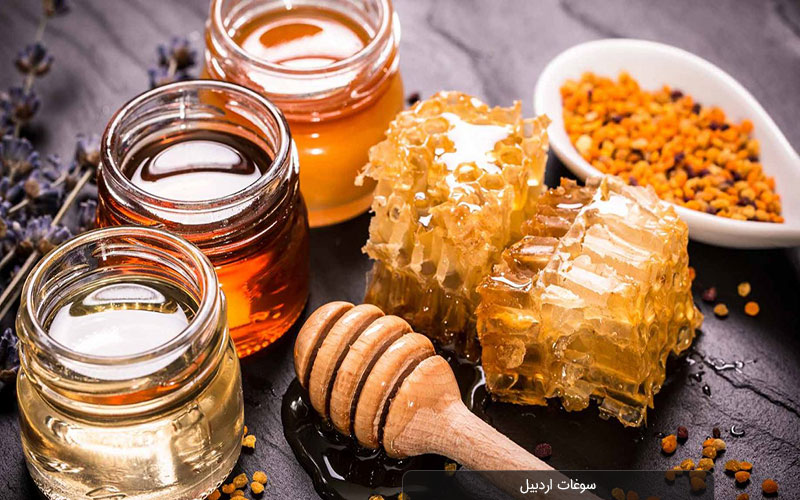
ginger halva; Fragrant sweets
Another one of the tastiest souvenirs of Ardabil is ginger halva. The foods of Ardabil, due to the location of this city in a cold region, usually have a warm nature. Ardabil souvenir ginger halva also has a warm nature due to the presence of ginger plant in it and is mostly consumed in winter. This halva is one of the popular sweets of Ardabilis during Ramadan.
Ginger halwa is prepared from flour, animal butter, sugar powder, ginger powder and saffron. Of course, in some other recipes of this halva, green cardamom powder, walnuts and solid or animal oil are also used. Ardabil ginger halva has a high nutritional value and is very nutritious. This halva is also very popular among other souvenirs of Ardabil.
Ardabil chocolates; A long-standing sweet
A 100-year-old Ardabil dessert, which is one of the tastiest and most delicious foods in Ardabil, and you can buy it as a souvenir of Ardabil for your friends. Unlike other Ardabil sweets, flour is not used in this sweet. Milk, sugar, sour cream, animal butter, cocoa, and walnuts are used to prepare the raste sweets. This chocolate is one of those souvenirs of Ardabil that cannot be easily passed by.
One of the things that makes Ardabil chocolate more special is its preparation, which takes 24 hours and requires great delicacy and precision. According to the confectioners of Ardabil who cook this sweet, if you neglect it for a moment, what you get will not be raste. One of the problems with this candy is the presence of foreign brands producing this chocolate in the markets of Ardabil, which do not have the aroma of the original Ardabil chocolate. If you want to buy Raste chocolate as a souvenir of Ardabil, buy from the confectioneries of this city to taste its real taste.
Sablan honey; a useful food from the heart of the mountains
Ardabil province is located near Sabalan mountain. Therefore, the production of natural honey has flourished in this area and it is called as the pole of honey production. Sablan honey is known as a souvenir of Ardabil, which is one of the high quality honeys of Iran. The reason is the existence of the plain of oregano, acacia, coriander, goon and thyme flowers
6.Copperware:
Ardabil is also known for its copper handicrafts. Intricately designed copper items like trays, vases, and utensils can be found in local markets.
Copperware holds a significant place in Ardabil’s traditional handicrafts. Artisans in Ardabil and other regions of Iran have a long history of crafting exquisite copper items, showcasing remarkable skill and artistry. Here’s more information about copperware in Ardabil:
Craftsmanship:
Copperware crafting involves skilled artisans who handcraft various items using traditional techniques that have been passed down through generations. These craftspeople create an array of objects like trays, vases, pots, pitchers, plates, and utensils.
Design and Decoration:
Ardabil’s copperware is often decorated with intricate engravings, etchings, and sometimes inlaid with silver or brass, showcasing traditional Persian designs, geometric patterns, floral motifs, and calligraphy. These designs not only add aesthetic appeal but also often carry cultural or symbolic significance.
Functionality and Durability:
Beyond their artistic value, copper items are durable and functional. They are well-suited for serving food and beverages and are often seen as decorative pieces in homes.
Cultural Significance:
Copperware has historically been highly valued in Iranian culture and used in various traditional ceremonies and rituals. It is seen as a symbol of elegance, beauty, and sometimes as a status symbol.
Production Process:
Craftsmen begin by selecting high-quality copper sheets, which are then shaped, hammered, and worked upon to create the desired form. The intricate designs are then skillfully etched or engraved onto the surface.
Acquiring Copperware:
Tourists and visitors to Ardabil can find copperware in local markets, bazaars, and specialized craft shops. Authentic pieces can often be purchased directly from artisans or reputable craft cooperatives.
Purchasing copperware from Ardabil not only offers a beautiful and functional piece but also supports local artisans, preserving the rich heritage of traditional Iranian craftsmanship. These items make excellent souvenirs, representing the cultural and artistic legacy of the region.
7.Traditional Clothing and Accessories:
Handmade traditional garments, including scarves, hats, and other clothing items, might be available as souvenirs, showcasing the local style and craftsmanship.
Traditional clothing and accessories in Ardabil, Iran, reflect the rich cultural heritage of the region. These garments and accessories often carry historical, cultural, and symbolic significance. Here’s a glimpse into traditional clothing and accessories in Ardabil:
Men’s Clothing:
Jubba: A long, loose-fitting outer garment worn by men, often made of wool or cotton and featuring intricate embroidery or decorative elements.
Shalvar: Loose trousers or pants worn underneath the jubba, usually wide-legged and comfortable for movement.
Pirahan: A traditional shirt worn underneath the jubba, often made of cotton and adorned with embroidery.
Women’s Clothing:
Chador: A large, flowing outer garment worn by women to cover their regular clothing. It is typically made of lightweight fabric and can vary in colors and designs.
Sarband: A type of headband or ribbon worn by women to tie around the head and keep the chador in place.
Accessories:
Scarf (Maghnaeh): Women in Ardabil and Iran often wear scarves, known as maghnaeh, to cover their heads and necks. These scarves come in various colors and can be intricately decorated with embroidery or patterns.
Jewelry: Traditional jewelry such as necklaces, earrings, bracelets, and rings play a significant role in completing traditional attire. These pieces are often made of silver or gold and can feature detailed designs and precious stones.
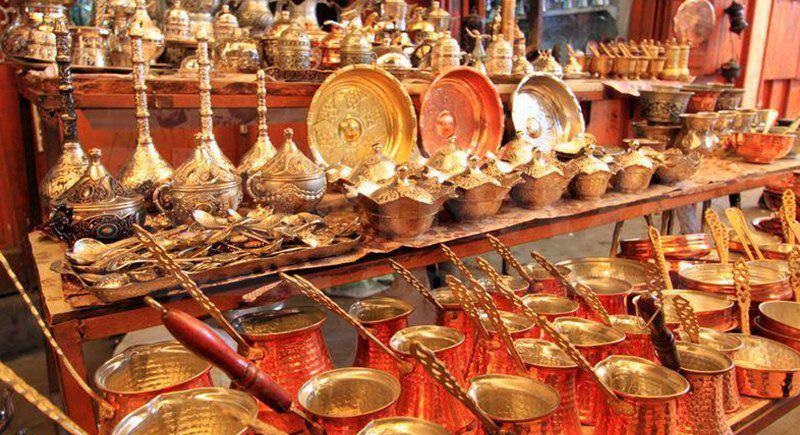
Fabrics and Textiles:
Termeh: A type of luxurious handmade fabric often used for clothing and accessories. It is usually made of silk and wool and woven with intricate patterns.
Glim: A type of colorful and patterned fabric used for various garments and accessories, known for its durability and vibrant colors.
Footwear:
Giveh: Handwoven shoes made of leather or fabric, usually worn by both men and women. They are comfortable and traditional, often featuring beautiful embroidery or designs.
When in Ardabil, you might find traditional clothing and accessories in local markets, specialty shops, or from artisans and craftsmen. These items not only represent the cultural heritage of the region but also make for unique and meaningful souvenirs, showcasing the traditional craftsmanship and style of Ardabil and Iran.
To find these souvenirs, you can visit local markets, bazaars, and specialized stores in Ardabil. The Saraye Moghan Bazaar is one of the traditional markets where you might discover these local products. It’s always a good idea to explore and engage with local artisans and craftsmen to get a more authentic experience and learn about the stories behind these souvenirs.
Conclusion
Ardabil, Iran, offers a rich tapestry of cultural heritage reflected in its diverse array of traditional crafts, local cuisine, and clothing. From its renowned carpets and rugs to the intricate copperware, the region showcases exceptional craftsmanship and artistry. Saffron, a prized spice, and traditional foods like Ashe Doogh, Mirza Ghasemi, and Aush tantalize the taste buds, offering a flavorful experience deeply rooted in the region’s culinary traditions.
Traditional clothing, with its elaborate designs and symbolic significance, represents the cultural identity of Ardabil. Men’s jubbas and shalvars, along with women’s chadors and intricate scarves, highlight the craftsmanship and cultural essence of the region. Handwoven textiles and footwear further contribute to the rich tapestry of local crafts.
Visitors exploring Ardabil can immerse themselves in its cultural mosaic by indulging in local cuisine, exploring the bustling markets for handmade crafts, and cherishing the opportunity to acquire souvenirs that encapsulate the artistry and cultural legacy of this historically rich region. From the stunning beauty of carpets to the allure of saffron and the intricate designs of copperware and clothing, Ardabil beckons with a treasure trove of cultural richness waiting to be discovered and appreciated.


